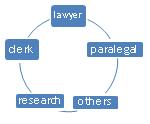
We're the ABA Damnit! We own you!
This was my 10th year at ABA Technology Show in Chicago. This year was particularly cool. Here’s why:
Meeting The Heavies: To me, seeing people like Dennis Kennedy, Tom Mighelle, Bob Ambrogi, Jim Calloway, Kevin O’Keefe, Brett Burney, Andy Atkins, Jay Foonberg (!) and the rest of my pretend blog friends … I mean pretend LinkedIn friends … is like reconnecting with long lost relatives. Exciting and a little intimidating. But all of them were really great and down to earth. Except that Kennedy. Such a prima donna. I kid, I kid.
Meeting Canadians: Who can forget meeting the Great Librarian of Upper Canada! Beat that. Then there was Phil of the Future (my name for him), Steve Matthews (nice guy), Brett Burney (I think he’s Canadian), Dominic Jaar (vive la Quebec libre!), the boys from Clio (or as I called them, the Booth Babes), and a host of other talent from the Great White North. It was great to meet you all: now go back where the ice doesn’t melt until July.
Technology Becoming Accepted: This year for the first time in memory I noticed a preponderance of grey hairs and the careful gait of partners scoping out potential buys for their offices. This was not the brash, flash-in-the-pan TechShow of the late-90’s in which the Internet was decried as a fad.
SaaS, Saas, and more Saas: Software as a service was all over the place, and by next year it will be pervasive. This year I was knocked out by the number and variety of kick-ass SaaS providers at the show including Clio, RocketMatter, and VLO Tech. Clio was my hands-down favorite for a number of reasons – I intend to use it in my own practice. Whatever your cup of tea, the idea of throwing away the IT department in favor of the Cloud is gaining traction fast.
Less is … Less: One lamentable fact about this year’s show – there was less of it than I’ve seen in a long time. Another casualty of the economy I’d say, but we shouldn’t overlook the fact that many legal technology vendors have been slaves to profit instead of boosters for innovation and the slow economy is making it painfully apparent what a royal screw job they’ve been giving lawyers all these years. Many players couldn’t make it ? Good riddance to bad company.
Other than that however, it was a great experience as always and one that I heartily recommend to one and all. If you haven’t been to TechShow, go there. If you have, come back. A splendid time is guaranteed for all.
For more coverage see my SmallLaw Column in TechnoLawyer.
Check out Twitter coverage of TechShow.
As always, I’d love your thoughts. E-mail me at mhedayat[at]mha-law.com or tweet me @practichacker.
ttyl 🙂
Posted in ABA, accounting, Adobe Acrobat, aggregator, ALM, Amicus, android, antitrust, Apple, Application, Avvo, bankruptcy, Bill Gates, Blogging, Blogroll, bookmarks, browser, business, Career and Job, careers, casestreaming, civility, collaborative tools, committee, community, competition, conduct, conference, cool stuff, Copy Right, corporate counsel, courts and, crowdsourcing, current-events, cybercontrols, de.licio.us, defamation, diigo, disruptive technology, document automation, document exchange, DRM, e-discovery, e-filing, e-mail, employment, enterprise, ESI, facebook, federal courts, feedburnerfeed101, feedreader, finanancial, FindLaw, firefox, FRCP, free, friendfeed, Google, Government, great conversations, hacking, IICLE, IL Bar Foundation, illinois supreme court, in house counsel, india, ipod, iPod Nano, jaiku, jobs, judiciary, knowledge management, law, legal marketplace, legislation, Lexis-Nexis, lifestreaming, lists, litigation, LPM Section, management, manager, Marketing, mass customization, mcle, Meeting, member perks, microblogging, Microsoft, Mobile device, moblogging, money, municipal government, myspace, news, Notice, outside counsel, outsourcing, PCLaw, PDA/SMARTPHONE, PDF, Podcast, Podcasting, Politics, poll, practice, practice management, privacy, radical transparency, records, recycling, referrals, remote, review, rss, SaaS, school, search, SEC Football, security, semantic search, SEO, slideshare, social networking, software, Sponsor, Steve Jobs, storage, tags, technology, Telephony & Voice Over IP, the business of law, tips, twitter, unbundling, Uncategorized, Video, Videoblog Notebook, web 2.0, website, Westlaw, widget, wiki, Wired, Wisdom of Crowds, work, youtube











You must be logged in to post a comment.